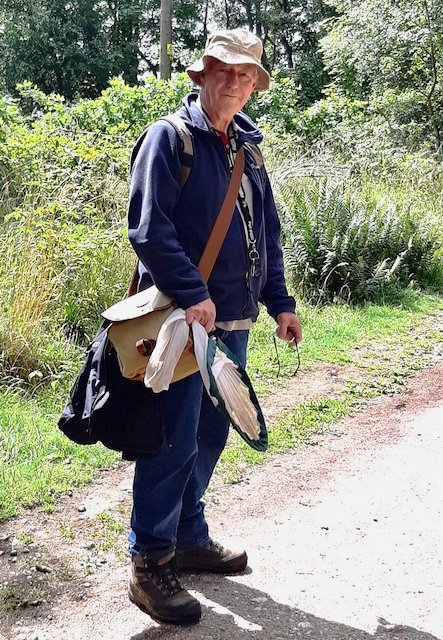The Belted Beauty
Male Belted Beauty, south of Potts Corner in 2011: Photo Steve Palmer
In three articles, we introduce the moths and butterflies found at the Point. These fascinating insects are familiar but have very different reputations. Many butterflies are a bright flash of colour in summer sunshine, while the moth is often, and unfairly, thought of as a pest of the night.
In the first article by Steve Palmer, we will focus on the splendidly named Belted Beauty, one of the most famous and rarest moths in the UK. Tomorrow, Pete Marsh will debunk myths about moths and provide an expert overview (with spectacular images) of the various species found around the village. Next week, Robert Hall, a former resident, will summarise the well-known butterflies that appear in spring and summer at Sunderland Point.
As always, there are many photographs - Editor.
Amongst the many fascinating and varied moth species recorded as present in the Sunderland Point area, the Belted Beauty is perhaps the best known to locals and visitors alike. Its national rarity mixed with an ability to survive on the open saltmarsh against all odds and the unusual nature of the moths themselves, make this an important and iconic species in Lancashire as well as throughout the British Isles.
The Belted Beauty was first noted on the coast north of Sunderland Point in 1975, when a botanist (Pat Livermore) found the distinctive caterpillar on the edge of the saltmarsh. It is unknown how long it had been in the area, but records of the moth exist back as far as 1832 in other part of North-west England. Since then, habitat loss driven mainly by extensive coastal development and changes in land use have dramatically reduced the number of populations present. Such was the pace of change, that by 2012, the Sunderland Point colony had become the last in England and Wales, although several colonies remain in some western parts of Scotland and Ireland.
Annual monitoring of the moth has taken place from Sunderland Point north to Potts Corner since the early 2000s, including in those early years by the Gilchrist family.
Female Belted Beauty, south of Potts Corner 2004: Photo Steve Palmer
The female Belted Beauty is wingless and to some extent resembles a large hairy wood-louse! The male is a more standard moth shape but rarely flies. Although obvious when seen up close, the caterpillar has a combination of grey colouring and a bright yellow stripe, making it cryptically marked when resting vertically on plant stems. The bright-green eggs are laid in cracks on old wooden stumps or within fallen rush seedheads. The caterpillar feeds on a wide variety of saltmarsh plants.
Belted Beauty Larva, south of Potts Corner 2010: Photo Karen Lawson
Monitoring of this moth (which appears from late March to mid-May), by counting resting females and males, is a really important element of protecting this seriously threatened species. Butterfly Conservation would welcome volunteers willing to carry out four or five annual daytime visits to count the moths, between the end of March and mid-May. If interested please contact Butterfly Conservation’s Ryan Clark (rclark@butterfly-conservation.org) for more details. General sightings of the moth or its caterpillar are warmly welcomed (please enter onto iRecord - https://irecord.org.uk/).
Steve Palmer 30/8/24
Brief biography
Born in Hertfordshire in the early 1950s and developed an interest in moths from a young age. Whilst working in Scotland in the late 1970s was introduced to Micro-moths. Involved in or produced a few books, including the Micro-moths of Wiltshire, a Field Guide to the Smaller British Moths and, with Ben Smart, The Moths of Lancashire in 2024. My main interest in recent years has been running the national Gelechiid Recording Scheme (a large family of Micro-moths). A retired Air Traffic Controller, I've lived in Preston with my wife and family since 1993.
Steve Palmer: Photo J Young
Many thanks Steve



